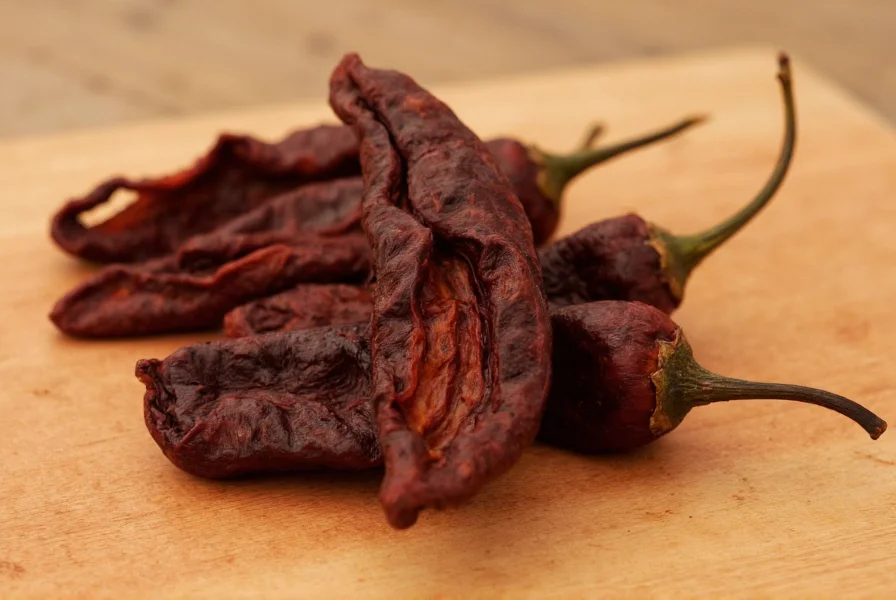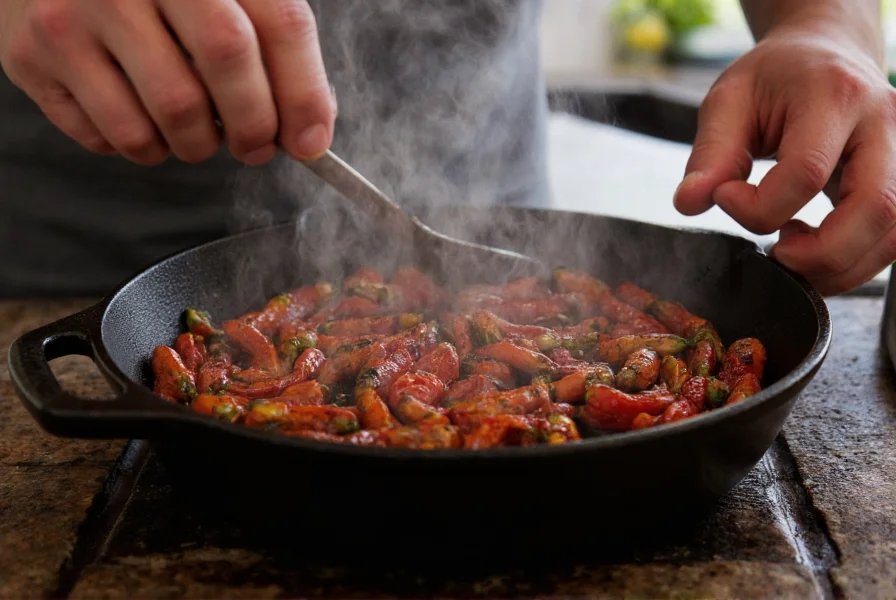Understanding what are ancho peppers begins with recognizing their origin as fully matured poblano peppers. Unlike fresh poblanos which are harvested green, ancho peppers come from poblanos allowed to ripen on the plant until they turn deep red. This ripening process significantly changes both flavor and heat characteristics.
The Transformation from Poblano to Ancho
The term "ancho" literally means "wide" in Spanish, referring to the pepper's broad, flat shape. When a poblano reaches full maturity and turns red, it's harvested and sun-dried. This drying process concentrates the sugars and develops complex flavor compounds that transform the mild, grassy fresh pepper into something with deep, smoky-sweet characteristics.

Flavor Profile and Heat Level
Among dried chiles, ancho pepper heat level ranks toward the milder end of the spectrum. At 1,000-2,000 Scoville Heat Units, they're significantly less spicy than jalapeños (2,500-8,000 SHU) and much milder than chipotles (2,500-10,000 SHU). Their flavor profile features:
- Pronounced notes of dried fruit (particularly raisins and prunes)
- Subtle coffee and cocoa undertones
- Earthy, slightly smoky characteristics
- Delicate sweetness that balances the mild heat
| Chile Type | Scoville Heat Units | Primary Flavor Notes |
|---|---|---|
| Ancho | 1,000-2,000 | Dried fruit, coffee, chocolate |
| Chipotle | 2,500-10,000 | Smoky, tobacco, wood |
| Guajillo | 2,500-5,000 | Tangy, berry, tea-like |
| Pasilla | 1,000-2,500 | Herbal, licorice, raisin |
Culinary Applications of Ancho Peppers
Chefs value how to use ancho peppers for their ability to add depth without overwhelming heat. Traditional applications include:
- Moles - Anchos form the base of many mole sauces, particularly mole poblano
- Adobo sauces - Their fruitiness complements vinegar-based marinades
- Stews and braises - Adds complexity to beef, pork, and bean dishes
- Spice rubs - Ground ancho works beautifully on meats before grilling
- Soups - Enhances flavor in black bean, tortilla, and vegetable soups
Ancho Pepper vs Chipotle: Understanding the Difference
Many home cooks confuse ancho pepper vs chipotle, but they're distinctly different:
- Anchos come from dried red poblanos and offer mild heat with fruity notes
- Chipotles are smoked and dried jalapeños with significantly more heat and pronounced smokiness
While both appear in Mexican cuisine, they serve different purposes. Anchos provide foundational flavor in sauces, while chipotles deliver smoky heat. Using them interchangeably will dramatically alter your dish's character.
Substituting Ancho Peppers
When you need an ancho pepper substitute, consider these options based on what aspect you're trying to replicate:
- For flavor: Mulato peppers (similar but slightly sweeter) or a combination of guajillo (for fruitiness) and a touch of pasilla (for depth)
- For heat level: New Mexico chiles or California chiles
- For powder form: Mix sweet paprika with a pinch of cayenne and a touch of cocoa powder
Remember that no substitute perfectly replicates ancho's unique flavor profile, but these alternatives can work in a pinch.
Preparing and Using Ancho Peppers
Before using whole dried anchos, proper preparation maximizes their flavor potential:
- Remove stems and seeds (the seeds contain most of the heat)
- Toast lightly in a dry skillet for 15-20 seconds per side until fragrant
- Soak in hot water for 15-20 minutes until softened
- Blend into sauces or chop for stews
For ancho chile powder uses, simply incorporate 1-2 teaspoons into rubs, soups, or sauces. The powder works particularly well in dry rubs for meats as it doesn't burn as easily as fresh chiles.

Nutritional Benefits
Beyond flavor, anchos offer nutritional advantages. They're rich in:
- Vitamin C (even in dried form)
- Vitamin A (from carotenoids in the red pepper)
- Dietary fiber
- Various antioxidants
Like all chile peppers, they contain capsaicin, which has been studied for potential metabolic and anti-inflammatory benefits, though in much smaller amounts than hotter varieties.
Storage and Selection Tips
When selecting dried poblano vs ancho pepper products:
- Look for deep, rich reddish-brown color (avoid faded or blackened specimens)
- They should feel pliable, not brittle (excessive brittleness indicates age)
- Whole peppers maintain flavor longer than pre-ground powder
- Store in airtight container away from light and heat
- Properly stored, they'll keep for 6-12 months
For best results, buy from specialty Mexican markets or reputable online spice retailers who have high turnover, ensuring freshness.
Conclusion
Ancho peppers represent one of the most versatile and flavorful ingredients in Mexican cooking. Their mild heat and complex flavor profile make them accessible to those who prefer less spicy foods while still delivering authentic taste. Whether you're making traditional mole, enhancing a simple soup, or creating a sophisticated spice rub, understanding how to properly select, prepare, and use ancho peppers will elevate your culinary creations significantly.
What's the difference between ancho peppers and poblano peppers?
Ancho peppers are simply dried poblano peppers. Poblanos are harvested green and used fresh, while anchos come from poblanos that have ripened to red on the plant before being harvested and dried. This drying process transforms both the flavor and heat characteristics.
How spicy are ancho peppers compared to other common chiles?
Ancho peppers rate between 1,000-2,000 Scoville Heat Units, making them milder than jalapeños (2,500-8,000 SHU) and significantly less spicy than chipotles (2,500-10,000 SHU). Their heat is subtle and balanced by rich, fruity flavors.
Can I substitute ancho chile powder for whole ancho peppers?
Yes, but with adjustments. As a general rule, 1 whole dried ancho pepper equals approximately 1½ teaspoons of ancho chile powder. However, whole peppers that have been toasted and soaked will provide more complex flavor than powder alone.
What are the best dishes to use ancho peppers in?
Ancho peppers excel in mole sauces (especially mole poblano), adobo marinades, chili con carne, bean dishes, and spice rubs for meats. Their mild heat and rich flavor make them ideal for dishes where you want chile flavor without overwhelming spiciness.
How should I store dried ancho peppers to maintain freshness?
Store dried ancho peppers in an airtight container away from light and heat. A cool, dark cupboard works well. Properly stored, they'll maintain quality for 6-12 months. For extended storage, keep them in the freezer where they can last up to 2 years while preserving flavor.
Frequently Asked Questions
What's the difference between ancho peppers and poblano peppers?
Ancho peppers are simply dried poblano peppers. Poblanos are harvested green and used fresh, while anchos come from poblanos that have ripened to red on the plant before being harvested and dried. This drying process transforms both the flavor and heat characteristics.
How spicy are ancho peppers compared to other common chiles?
Ancho peppers rate between 1,000-2,000 Scoville Heat Units, making them milder than jalapeños (2,500-8,000 SHU) and significantly less spicy than chipotles (2,500-10,000 SHU). Their heat is subtle and balanced by rich, fruity flavors.
Can I substitute ancho chile powder for whole ancho peppers?
Yes, but with adjustments. As a general rule, 1 whole dried ancho pepper equals approximately 1½ teaspoons of ancho chile powder. However, whole peppers that have been toasted and soaked will provide more complex flavor than powder alone.
What are the best dishes to use ancho peppers in?
Ancho peppers excel in mole sauces (especially mole poblano), adobo marinades, chili con carne, bean dishes, and spice rubs for meats. Their mild heat and rich flavor make them ideal for dishes where you want chile flavor without overwhelming spiciness.
How should I store dried ancho peppers to maintain freshness?
Store dried ancho peppers in an airtight container away from light and heat. A cool, dark cupboard works well. Properly stored, they'll maintain quality for 6-12 months. For extended storage, keep them in the freezer where they can last up to 2 years while preserving flavor.











 浙公网安备
33010002000092号
浙公网安备
33010002000092号 浙B2-20120091-4
浙B2-20120091-4